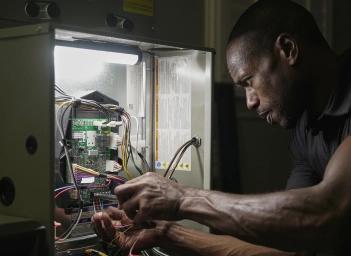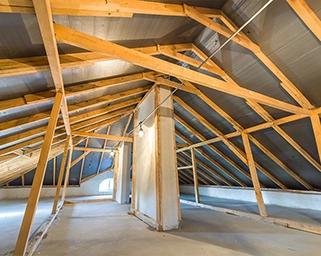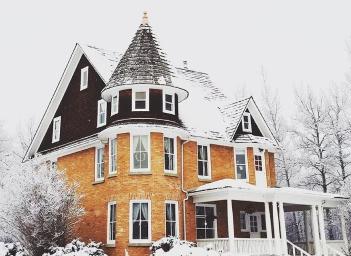Extreme Winter Weather Preparation for Your Home and HVAC
Learn how to prepare your home and HVAC system for whatever Old Man Winter sends your way.
While some parts of the country have already seen the first snowfall of the season, others are enjoying the last warm days for a while. Now is a great time to think about how to prepare your home and HVAC system for winter weather. By the time a winter storm warning or blizzard warning is issued, or a polar vortex settles in, you should already be prepared.
Check out these tips and tricks for getting your home ready for extreme weather, protecting your HVAC system, and being prepared in the event of a power outage or deep snow.
Prepare your home for winter weather
To ensure you’re warm and safe, it’s essential to think ahead, before winter weather strikes. Weatherproofing your home includes a wide range of tasks you can handle as a DIY job. You may also want to hire a professional.
- Caulk or add weatherstripping to seal leaks around doors and windows.
- Install garage door insulation and weatherstripping - kits are available.
- Add attic insulation if needed.
- Add window insulation to single-pane windows using plastic window coverings and drapes.
- Insulate exterior waterlines to prevent freezing or bursting pipes.
- Trim tree branches that are overhanging your home. Freezing rain and heavy snow can cause branches to fall, which could damage your roof.
- Clear out enough room in your garage to park the car and protect it from a hail storm, ice, or heavy snow.
If you have a fireplace
If you have a wood fireplace, stock up on firewood - enough to get you through a few days without power. Get your chimney inspected each fall and cleaned if needed. Test your smoke alarms and carbon monoxide detectors as well.
When extreme winter weather is in the forecast
If you’re under a winter storm watch, make sure you have sufficient food, water, and medications on hand — including what you need for your pets. Stock up on batteries for your flashlights and matches or lighters for candles in case the power goes out. Fully charge your phone.
In addition to your local TV and radio stations, your smartphone and weather.com are excellent resources for weather updates. Ready.gov is an invaluable resource for preparing for all kinds of emergencies, including winter weather.
HVAC maintenance tips to prepare your HVAC system for winter weather
Whether you’re expecting a blizzard, blustery winds, or extreme cold, you want to make sure your heating system is ready to go when bad weather arrives. (Note: If it’s the first time you’re using your heat, see our blog to find out what odors are normal and when to get expert help: Why Your Heater Smells Like It’s Burning.)
Here are our top home HVAC maintenance tips for winter weather:
- Schedule a heat pump or furnace tune-up. The first step is to have an HVAC technician do a thorough heating system inspection, which will give you the peace of mind that your furnace or heat pump is operating properly. A heat pump or furnace tune-up is part of preventive maintenance. It can save you money over the long haul by catching issues early too.
- Check/change the HVAC air filters more often. When it’s cold outside and your heating system runs more often and longer, you’ll want to change your filters more frequently — so have replacements handy. Sign up for filter delivery with Trane® Filters powered by FilterTime™.
- Check your air vents. Make sure you don’t have any obstructed airflow. Move furniture and curtains away from the registers to allow warm air to flow unimpeded. Not only does blocking vents prevent warm air from circulating, it can put undue stress on your HVAC system.
- Verify that your thermostat is working correctly. In addition, consider investing in a smart thermostat, which offers the ability to control temperatures remotely when you are not at home, as well as regular programming functions to suit your lifestyle.
While we’re on the topic of HVAC equipment, some additional thoughts on winterizing your air conditioning unit. Outdoor HVAC equipment is built to withstand the elements, but if you live in an area that gets lots of snow and ice, you should consider covering your AC unit.
Keep in mind, though, that you don’t want to use an airtight, watertight cover — it should be a breathable cover such as the WeatherGuard™ air conditioner cover that doesn’t lock in moisture. And if you’re wondering if you need to run your AC in winter to keep it functioning, the answer is no. It can harm the unit if the outdoor temperature is below 60 or 65 degrees Fahrenheit.
Pro tip: Don’t cover your heat pump. Although they function as an air conditioner in warm weather, they’re built to run during cold weather…so you’re A-OK! In case of snow, you do want to clear it from the top and sides of your heat pump to keep it working properly.
Plan for extreme winter weather with a generator
According to the U.S. Energy Information Administration, U.S. electricity customers lose power for about 5 ½ hours a year, excluding major events such as winter storms and hurricanes. If you live in an area commonly affected by extreme weather, you know from experience that outages can last days or weeks. In addition to an uncomfortable indoor environment, the result can be a cascade of problems from frozen or broken pipes to a freezer or refrigerator full of food that is now unsafe to eat.
Generators can often be a solution, but the number of choices may make your head spin. Small generators can cost a few hundred dollars, while a whole-house system can run $10,000 or more. Here are some of the considerations:
- How much power do you need? This is a matter of math, adding up the wattages of all the appliances and devices you need to run — considering that some equipment uses a surge of wattage on startup, such as refrigerators, air conditioners, and heat pumps. In general, newer gas furnaces use less than 600 watts. The wattage a heat pump uses is considerably higher, depending on the tonnage and other factors.
- Do you have long or frequent outages? Are the power lines above ground or below? In areas that commonly have significant storms, a home standby unit or large inverter with sufficient wattage may make the most sense. It can be connected to your home’s circuit breaker by a licensed electrician, including a transfer switch, and can power all of your hardwired HVAC and appliances.
- Are you looking for a “just-in-case” solution? Depending on the wattage, midsized inverters can power items with standard plugs, such as the refrigerator, a small space heater, some lights, and your devices. Some of the more powerful portable generators on the market range as high as 7,500 watts, but noise is a downside, as well as the expense if you want to connect it to your circuit breaker.
If you’re unsure what generator type would work best for your home size and specific heating and cooling system, your local Trane dealer or technician can provide a professional recommendation.
In the event of heavy snow
Finally, clear heavy snow off of the top of your outdoor unit. If you have a condensing furnace with an intake pipe and an exhaust pipe near your outdoor unit, make sure they are not buried under a snow drift. If blowing snow is continuous, check more than once.
If you have a fire hydrant in front of your home, consider digging it out as well. Time is of the essence in case of a fire. You could save your neighbor’s house by giving the fire department extra time to fight a fire.
Schedule HVAC maintenance now
If you haven’t had a furnace tuneup of professional heat pump maintenance in a while, schedule it now to help ensure your heating system is operating safely and at peak performance before the winter season starts. Contact your local Trane Comfort Specialist now.




